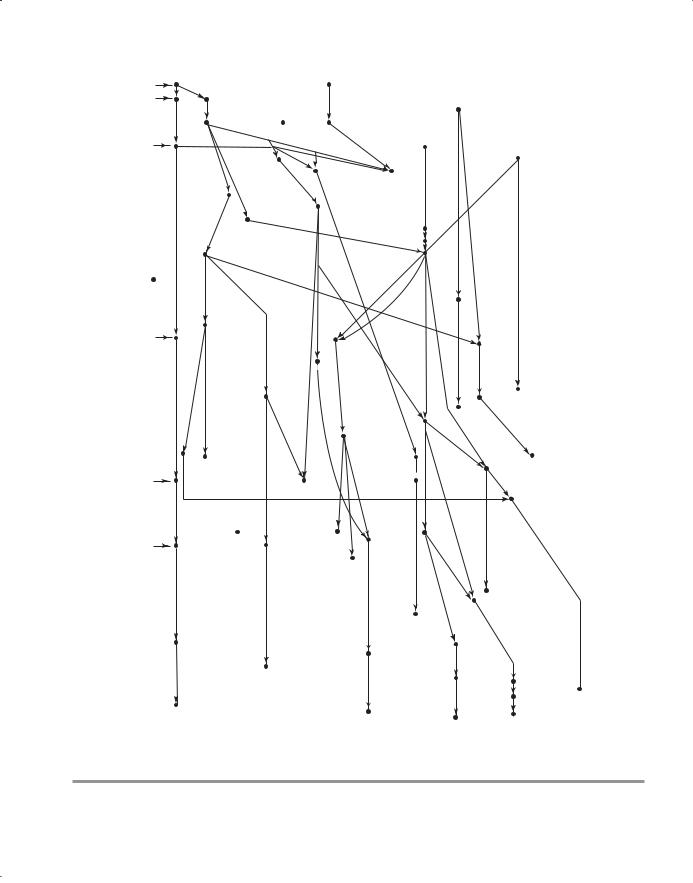
- •New to the Tenth Edition
- •Preface
- •Acknowledgments
- •About the Author
- •Contents
- •1.1 Reasons for Studying Concepts of Programming Languages
- •1.2 Programming Domains
- •1.3 Language Evaluation Criteria
- •1.4 Influences on Language Design
- •1.5 Language Categories
- •1.6 Language Design Trade-Offs
- •1.7 Implementation Methods
- •1.8 Programming Environments
- •Summary
- •Problem Set
- •2.1 Zuse’s Plankalkül
- •2.2 Pseudocodes
- •2.3 The IBM 704 and Fortran
- •2.4 Functional Programming: LISP
- •2.5 The First Step Toward Sophistication: ALGOL 60
- •2.6 Computerizing Business Records: COBOL
- •2.7 The Beginnings of Timesharing: BASIC
- •2.8 Everything for Everybody: PL/I
- •2.9 Two Early Dynamic Languages: APL and SNOBOL
- •2.10 The Beginnings of Data Abstraction: SIMULA 67
- •2.11 Orthogonal Design: ALGOL 68
- •2.12 Some Early Descendants of the ALGOLs
- •2.13 Programming Based on Logic: Prolog
- •2.14 History’s Largest Design Effort: Ada
- •2.15 Object-Oriented Programming: Smalltalk
- •2.16 Combining Imperative and Object-Oriented Features: C++
- •2.17 An Imperative-Based Object-Oriented Language: Java
- •2.18 Scripting Languages
- •2.19 The Flagship .NET Language: C#
- •2.20 Markup/Programming Hybrid Languages
- •Review Questions
- •Problem Set
- •Programming Exercises
- •3.1 Introduction
- •3.2 The General Problem of Describing Syntax
- •3.3 Formal Methods of Describing Syntax
- •3.4 Attribute Grammars
- •3.5 Describing the Meanings of Programs: Dynamic Semantics
- •Bibliographic Notes
- •Problem Set
- •4.1 Introduction
- •4.2 Lexical Analysis
- •4.3 The Parsing Problem
- •4.4 Recursive-Descent Parsing
- •4.5 Bottom-Up Parsing
- •Summary
- •Review Questions
- •Programming Exercises
- •5.1 Introduction
- •5.2 Names
- •5.3 Variables
- •5.4 The Concept of Binding
- •5.5 Scope
- •5.6 Scope and Lifetime
- •5.7 Referencing Environments
- •5.8 Named Constants
- •Review Questions
- •6.1 Introduction
- •6.2 Primitive Data Types
- •6.3 Character String Types
- •6.4 User-Defined Ordinal Types
- •6.5 Array Types
- •6.6 Associative Arrays
- •6.7 Record Types
- •6.8 Tuple Types
- •6.9 List Types
- •6.10 Union Types
- •6.11 Pointer and Reference Types
- •6.12 Type Checking
- •6.13 Strong Typing
- •6.14 Type Equivalence
- •6.15 Theory and Data Types
- •Bibliographic Notes
- •Programming Exercises
- •7.1 Introduction
- •7.2 Arithmetic Expressions
- •7.3 Overloaded Operators
- •7.4 Type Conversions
- •7.5 Relational and Boolean Expressions
- •7.6 Short-Circuit Evaluation
- •7.7 Assignment Statements
- •7.8 Mixed-Mode Assignment
- •Summary
- •Problem Set
- •Programming Exercises
- •8.1 Introduction
- •8.2 Selection Statements
- •8.3 Iterative Statements
- •8.4 Unconditional Branching
- •8.5 Guarded Commands
- •8.6 Conclusions
- •Programming Exercises
- •9.1 Introduction
- •9.2 Fundamentals of Subprograms
- •9.3 Design Issues for Subprograms
- •9.4 Local Referencing Environments
- •9.5 Parameter-Passing Methods
- •9.6 Parameters That Are Subprograms
- •9.7 Calling Subprograms Indirectly
- •9.8 Overloaded Subprograms
- •9.9 Generic Subprograms
- •9.10 Design Issues for Functions
- •9.11 User-Defined Overloaded Operators
- •9.12 Closures
- •9.13 Coroutines
- •Summary
- •Programming Exercises
- •10.1 The General Semantics of Calls and Returns
- •10.2 Implementing “Simple” Subprograms
- •10.3 Implementing Subprograms with Stack-Dynamic Local Variables
- •10.4 Nested Subprograms
- •10.5 Blocks
- •10.6 Implementing Dynamic Scoping
- •Problem Set
- •Programming Exercises
- •11.1 The Concept of Abstraction
- •11.2 Introduction to Data Abstraction
- •11.3 Design Issues for Abstract Data Types
- •11.4 Language Examples
- •11.5 Parameterized Abstract Data Types
- •11.6 Encapsulation Constructs
- •11.7 Naming Encapsulations
- •Summary
- •Review Questions
- •Programming Exercises
- •12.1 Introduction
- •12.2 Object-Oriented Programming
- •12.3 Design Issues for Object-Oriented Languages
- •12.4 Support for Object-Oriented Programming in Smalltalk
- •12.5 Support for Object-Oriented Programming in C++
- •12.6 Support for Object-Oriented Programming in Objective-C
- •12.7 Support for Object-Oriented Programming in Java
- •12.8 Support for Object-Oriented Programming in C#
- •12.9 Support for Object-Oriented Programming in Ada 95
- •12.10 Support for Object-Oriented Programming in Ruby
- •12.11 Implementation of Object-Oriented Constructs
- •Summary
- •Programming Exercises
- •13.1 Introduction
- •13.2 Introduction to Subprogram-Level Concurrency
- •13.3 Semaphores
- •13.4 Monitors
- •13.5 Message Passing
- •13.6 Ada Support for Concurrency
- •13.7 Java Threads
- •13.8 C# Threads
- •13.9 Concurrency in Functional Languages
- •13.10 Statement-Level Concurrency
- •Summary
- •Review Questions
- •Problem Set
- •14.1 Introduction to Exception Handling
- •14.2 Exception Handling in Ada
- •14.3 Exception Handling in C++
- •14.4 Exception Handling in Java
- •14.5 Introduction to Event Handling
- •14.6 Event Handling with Java
- •14.7 Event Handling in C#
- •Review Questions
- •Problem Set
- •15.1 Introduction
- •15.2 Mathematical Functions
- •15.3 Fundamentals of Functional Programming Languages
- •15.4 The First Functional Programming Language: LISP
- •15.5 An Introduction to Scheme
- •15.6 Common LISP
- •15.8 Haskell
- •15.10 Support for Functional Programming in Primarily Imperative Languages
- •15.11 A Comparison of Functional and Imperative Languages
- •Review Questions
- •Problem Set
- •16.1 Introduction
- •16.2 A Brief Introduction to Predicate Calculus
- •16.3 Predicate Calculus and Proving Theorems
- •16.4 An Overview of Logic Programming
- •16.5 The Origins of Prolog
- •16.6 The Basic Elements of Prolog
- •16.7 Deficiencies of Prolog
- •16.8 Applications of Logic Programming
- •Review Questions
- •Programming Exercises
- •Bibliography
- •Index

Summary 31
1.8 Programming Environments
A programming environment is the collection of tools used in the development of software. This collection may consist of only a file system, a text editor, a linker, and a compiler. Or it may include a large collection of integrated tools, each accessed through a uniform user interface. In the latter case, the development and maintenance of software is greatly enhanced. Therefore, the characteristics of a programming language are not the only measure of the software development capability of a system. We now briefly describe several programming environments.
UNIX is an older programming environment, first distributed in the middle 1970s, built around a portable multiprogramming operating system. It provides a wide array of powerful support tools for software production and maintenance in a variety of languages. In the past, the most important feature absent from UNIX was a uniform interface among its tools. This made it more difficult to learn and to use. However, UNIX is now often used through a graphical user interface (GUI) that runs on top of UNIX. Examples of UNIX GUIs are the Solaris Common Desktop Environment (CDE), GNOME, and KDE. These GUIs make the interface to UNIX appear similar to that of Windows and Macintosh systems.
Borland JBuilder is a programming environment that provides an integrated compiler, editor, debugger, and file system for Java development, where all four are accessed through a graphical interface. JBuilder is a complex and powerful system for creating Java software.
Microsoft Visual Studio .NET is a relatively recent step in the evolution of software development environments. It is a large and elaborate collection of software development tools, all used through a windowed interface. This system can be used to develop software in any one of the five .NET languages: C#, Visual BASIC .NET, JScript (Microsoft’s version of JavaScript), F# (a functional language), and C++/CLI.
NetBeans is a development environment that is primarily used for Java application development but also supports JavaScript, Ruby, and PHP. Both Visual Studio and NetBeans are more than development environments—they are also frameworks, which means they actually provide common parts of the code of the application.
S U M M A R Y
The study of programming languages is valuable for some important reasons: It increases our capacity to use different constructs in writing programs, enables us to choose languages for projects more intelligently, and makes learning new languages easier.
Computers are used in a wide variety of problem-solving domains. The design and evaluation of a particular programming language is highly dependent on the domain in which it is to be used.

32 |
Chapter 1 Preliminaries |
Among the most important criteria for evaluating languages are readability, writability, reliability, and overall cost. These will be the basis on which we examine and judge the various language features discussed in the remainder of the book.
The major influences on language design have been machine architecture and software design methodologies.
Designing a programming language is primarily an engineering feat, in which a long list of trade-offs must be made among features, constructs, and capabilities.
The major methods of implementing programming languages are compilation, pure interpretation, and hybrid implementation.
Programming environments have become important parts of software development systems, in which the language is just one of the components.
R E V I E W Q U E S T I O N S
1.Why is it useful for a programmer to have some background in language design, even though he or she may never actually design a programming language?
2.How can knowledge of programming language characteristics benefit the whole computing community?
3.What programming language has dominated scientific computing over the past 50 years?
4.What programming language has dominated business applications over the past 50 years?
5.What programming language has dominated artificial intelligence over the past 50 years?
6.In what language is most of UNIX written?
7.What is the disadvantage of having too many features in a language?
8.How can user-defined operator overloading harm the readability of a program?
9.What is one example of a lack of orthogonality in the design of C?
10.What language used orthogonality as a primary design criterion?
11.What primitive control statement is used to build more complicated control statements in languages that lack them?
12.What construct of a programming language provides process abstraction?
13.What does it mean for a program to be reliable?
14.Why is type checking the parameters of a subprogram important?
15.What is aliasing?

Problem Set |
33 |
16.What is exception handling?
17.Why is readability important to writability?
18.How is the cost of compilers for a given language related to the design of that language?
19.What have been the strongest influences on programming language design over the past 50 years?
20.What is the name of the category of programming languages whose structure is dictated by the von Neumann computer architecture?
21.What two programming language deficiencies were discovered as a result of the research in software development in the 1970s?
22.What are the three fundamental features of an object-oriented programming language?
23.What language was the first to support the three fundamental features of object-oriented programming?
24.What is an example of two language design criteria that are in direct conflict with each other?
25.What are the three general methods of implementing a programming language?
26.Which produces faster program execution, a compiler or a pure interpreter?
27.What role does the symbol table play in a compiler?
28.What does a linker do?
29.Why is the von Neumann bottleneck important?
30.What are the advantages in implementing a language with a pure interpreter?
P R O B L E M S E T
1.Do you believe our capacity for abstract thought is influenced by our language skills? Support your opinion.
2.What are some features of specific programming languages you know whose rationales are a mystery to you?
3.What arguments can you make for the idea of a single language for all programming domains?
4.What arguments can you make against the idea of a single language for all programming domains?
5.Name and explain another criterion by which languages can be judged (in addition to those discussed in this chapter).

34Chapter 1 Preliminaries
6.What common programming language statement, in your opinion, is most detrimental to readability?
7.Java uses a right brace to mark the end of all compound statements. What are the arguments for and against this design?
8.Many languages distinguish between uppercase and lowercase letters in user-defined names. What are the pros and cons of this design decision?
9.Explain the different aspects of the cost of a programming language.
10.What are the arguments for writing efficient programs even though hardware is relatively inexpensive?
11.Describe some design trade-offs between efficiency and safety in some language you know.
12.In your opinion, what major features would a perfect programming language include?
13.Was the first high-level programming language you learned implemented with a pure interpreter, a hybrid implementation system, or a compiler? (You may have to research this.)
14.Describe the advantages and disadvantages of some programming environment you have used.
15.How do type declaration statements for simple variables affect the readability of a language, considering that some languages do not require them?
16.Write an evaluation of some programming language you know, using the criteria described in this chapter.
17.Some programming languages—for example, Pascal—have used the semicolon to separate statements, while Java uses it to terminate statements. Which of these, in your opinion, is most natural and least likely to result in syntax errors? Support your answer.
18.Many contemporary languages allow two kinds of comments: one in which delimiters are used on both ends (multiple-line comments), and one in which a delimiter marks only the beginning of the comment (oneline comments). Discuss the advantages and disadvantages of each of these with respect to our criteria.

2
Evolution of the Major
Programming Languages
2.1Zuse’s Plankalkül
2.2Pseudocodes
2.3The IBM 704 and Fortran
2.4Functional Programming: LISP
2.5The First Step Toward Sophistication: ALGOL 60
2.6Computerizing Business Records: COBOL
2.7The Beginnings of Timesharing: BASIC
2.8Everything for Everybody: PL/I
2.9Two Early Dynamic Languages: APL and SNOBOL
2.10 The Beginnings of Data Abstraction: SIMULA 67
2.11 Orthogonal Design: ALGOL 68
2.12 Some Early Descendants of the ALGOLs
2.13 Programming Based on Logic: Prolog
2.14 History’s Largest Design Effort: Ada
2.15 Object-Oriented Programming: Smalltalk
2.16 Combining Imperative and Object-Oriented Features: C++
2.17 An Imperative-Based Object-Oriented Language: Java
2.18 Scripting Languages
2.19 The Flagship .NET Language: C#
2.20 Markup/Programming Hybrid Languages
35

36 |
Chapter 2 Evolution of the Major Programming Languages |
This chapter describes the development of a collection of programming languages. It explores the environment in which each was designed and focuses on the contributions of the language and the motivation for its development.
Overall language descriptions are not included; rather, we discuss only some of the new features introduced by each language. Of particular interest are the features that most influenced subsequent languages or the field of computer science.
This chapter does not include an in-depth discussion of any language feature or concept; that is left for later chapters. Brief, informal explanations of features will suffice for our trek through the development of these languages.
This chapter discusses a wide variety of languages and language concepts that will not be familiar to many readers. These topics are discussed in detail only in later chapters. Those who find this unsettling may prefer to delay reading this chapter until the rest of the book has been studied.
The choice as to which languages to discuss here was subjective, and some readers will unhappily note the absence of one or more of their favorites. However, to keep this historical coverage to a reasonable size, it was necessary to leave out some languages that some regard highly. The choices were based on our estimate of each language’s importance to language development and the computing world as a whole. We also include brief discussions of some other languages that are referenced later in the book.
The organization of this chapter is as follows: The initial versions of languages generally are discussed in chronological order. However, subsequent versions of languages appear with their initial version, rather than in later sections. For example, Fortran 2003 is discussed in the section with Fortran I (1956). Also, in some cases, languages of secondary importance that are related to a language that has its own section appear in that section.
This chapter includes listings of 14 complete example programs, each in a different language. These programs are not described in this chapter; they are meant simply to illustrate the appearance of programs in these languages. Readers familiar with any of the common imperative languages should be able to read and understand most of the code in these programs, except those in LISP, COBOL, and Smalltalk.
(A Scheme function similar to the LISP example is discussed in Chapter 15.) The same problem is solved by the Fortran, ALGOL 60, PL/I, BASIC, Pascal, C, Perl, Ada, Java, JavaScript, and C# programs. Note that most of the contemporary languages in this list support dynamic arrays, but because of the simplicity of the example problem, we did not use them in the example programs. Also, in the Fortran 95 program, we avoided using the features that could have avoided the use of loops altogether, in part to keep the program simple and readable and in part just to illustrate the basic loop structure of the language.
Figure 2.1 is a chart of the genealogy of the high-level languages discussed in this chapter.

Chapter 2 Evolution of the Major Programming Languages |
37 |
1957 |
Fortran I |
|
|
FLOW-MATIC |
|
|
|
|
58 |
Fortran II |
ALGOL 58 |
|
|
|
|
|
|
59 |
|
ALGOL 60 |
|
|
|
|
LISP |
|
60 |
|
APL |
COBOL |
|
|
|
||
61 |
|
|
|
|
|
|
|
|
62 |
Fortran IV |
|
|
|
|
CPL |
|
SNOBOL |
63 |
|
SIMULA I |
|
|
|
|
|
|
64 |
|
|
|
BASIC |
PL/I |
|
|
|
65 |
|
|
|
|
|
|
|
|
66 |
ALGOL W |
|
|
|
|
|
|
|
67 |
|
SIMULA 67 |
|
|
|
|
||
68 |
|
ALGOL 68 |
|
|
|
|
|
|
69 |
|
|
|
|
|
BCPL |
|
|
70 |
|
Pascal |
|
|
|
B |
|
|
71 |
|
|
|
|
C |
|
|
|
72 |
|
|
|
|
|
|
|
|
73 |
Prolog |
|
|
|
|
|
|
|
74 |
|
|
|
|
|
|
Scheme |
|
75 |
|
|
|
|
|
|
|
|
|
|
|
|
|
|
|
|
|
76 |
|
MODULA-2 |
|
|
|
|
|
|
77 |
|
|
|
|
|
|
|
|
78 |
Fortran 77 |
|
|
awk |
|
ML |
|
|
79 |
|
|
|
|
|
|||
|
|
|
Smalltalk 80 |
|
|
|
||
80 |
|
|
|
|
|
|
||
|
|
|
|
|
|
|
|
|
81 |
|
|
|
|
|
|
|
|
82 |
|
|
Ada 83 |
|
|
|
|
ICON |
83 |
|
|
|
|
|
Miranda |
||
84 |
|
|
|
|
|
C++ |
COMMON LISP |
|
85 |
|
|
|
|
|
|||
|
|
|
|
|
|
|
|
|
86 |
|
|
|
|
Perl |
|
|
|
87 |
MODULA-3 |
Oberon |
|
|
QuickBASIC |
|
|
Haskell |
88 |
|
|
|
|
||||
89 |
Fortran 90 |
|
|
Eiffel |
Visual BASIC |
|
ANSI C (C89) |
|
90 |
|
|
|
|
|
|||
91 |
|
|
|
|
|
|
|
Python |
92 |
|
|
|
|
|
|
|
|
|
|
|
|
|
|
|
|
|
93 |
|
Lua |
|
PHP |
|
|
|
|
94 |
Fortran 95 |
|
Ruby |
Java |
|
|
||
95 |
|
Ada 95 |
|
|
|
|
||
96 |
|
|
|
Javascript |
|
|
|
|
97 |
|
|
|
|
|
|
||
98 |
|
|
|
|
|
|
C99 |
|
99 |
|
|
|
|
|
|
|
|
00 |
|
|
|
|
|
|
C# |
|
01 |
|
|
|
Visual Basic.NET |
|
|
|
|
02 |
|
|
|
|
|
|
|
|
03 |
Fortran 2003 |
|
|
|
Ruby 1.8 |
|
Java 5.0 |
|
04 |
|
|
|
|
|
|
||
05 |
|
|
Ada 2005 |
|
|
|
|
|
06 |
|
|
|
|
Java 6.0 |
C# 2.0 |
||
|
|
|
|
|
|
|||
07 |
|
|
|
|
|
|
|
C# 3.0 |
08 |
Fortran 2008 |
|
|
|
Ruby 1.9 |
|
|
|
|
|
|
|
|
C# 4.0 |
|||
09 |
|
|
|
|
|
|
Java 7.0 |
|
10 |
|
|
|
|
|
|
|
|
|
|
|
|
|
|
|
|
|
11 |
|
|
|
|
|
|
|
|
 Python 2.0
Python 2.0
 Python 3.0
Python 3.0
Figure 2.1
Genealogy of common high-level programming languages
